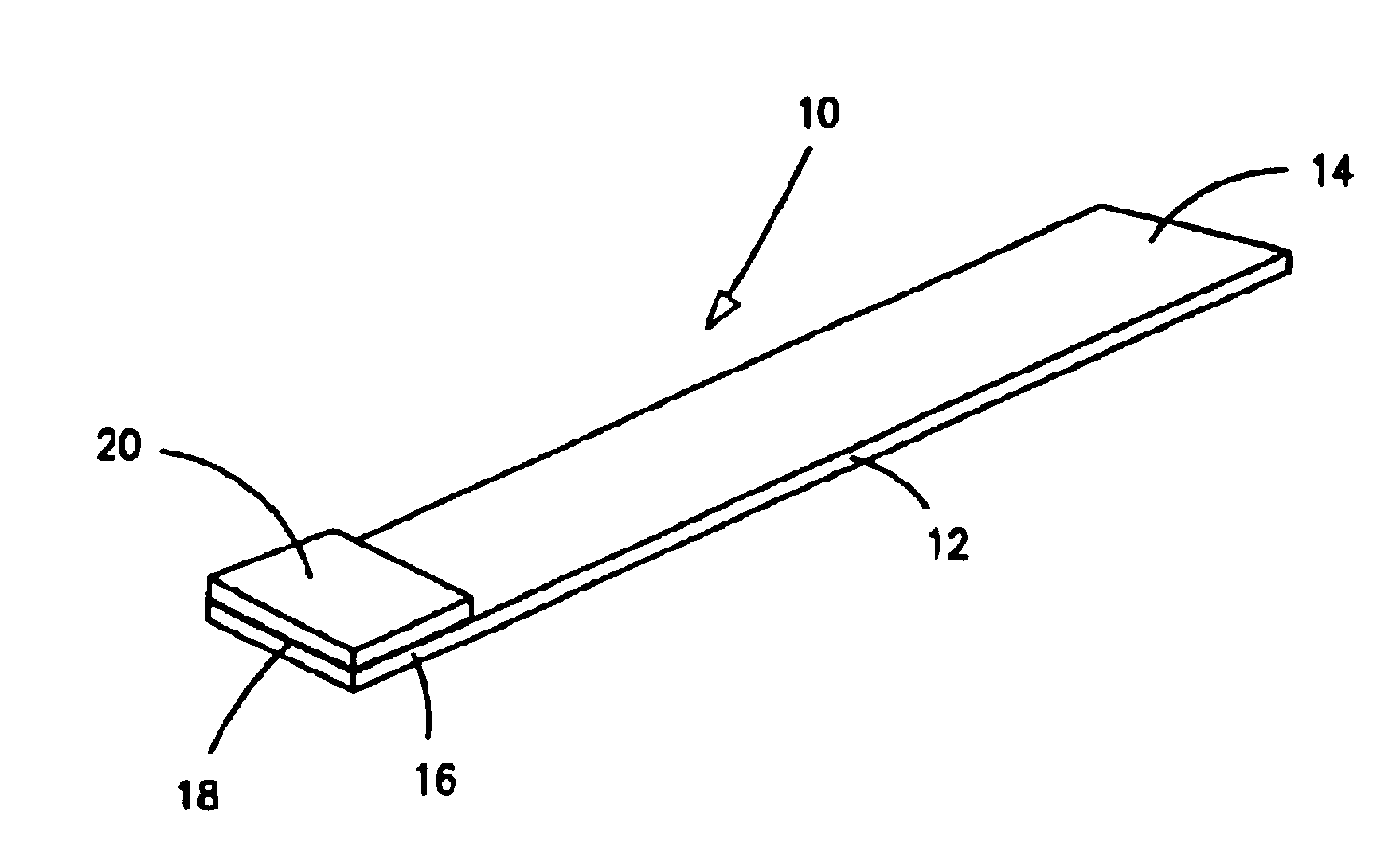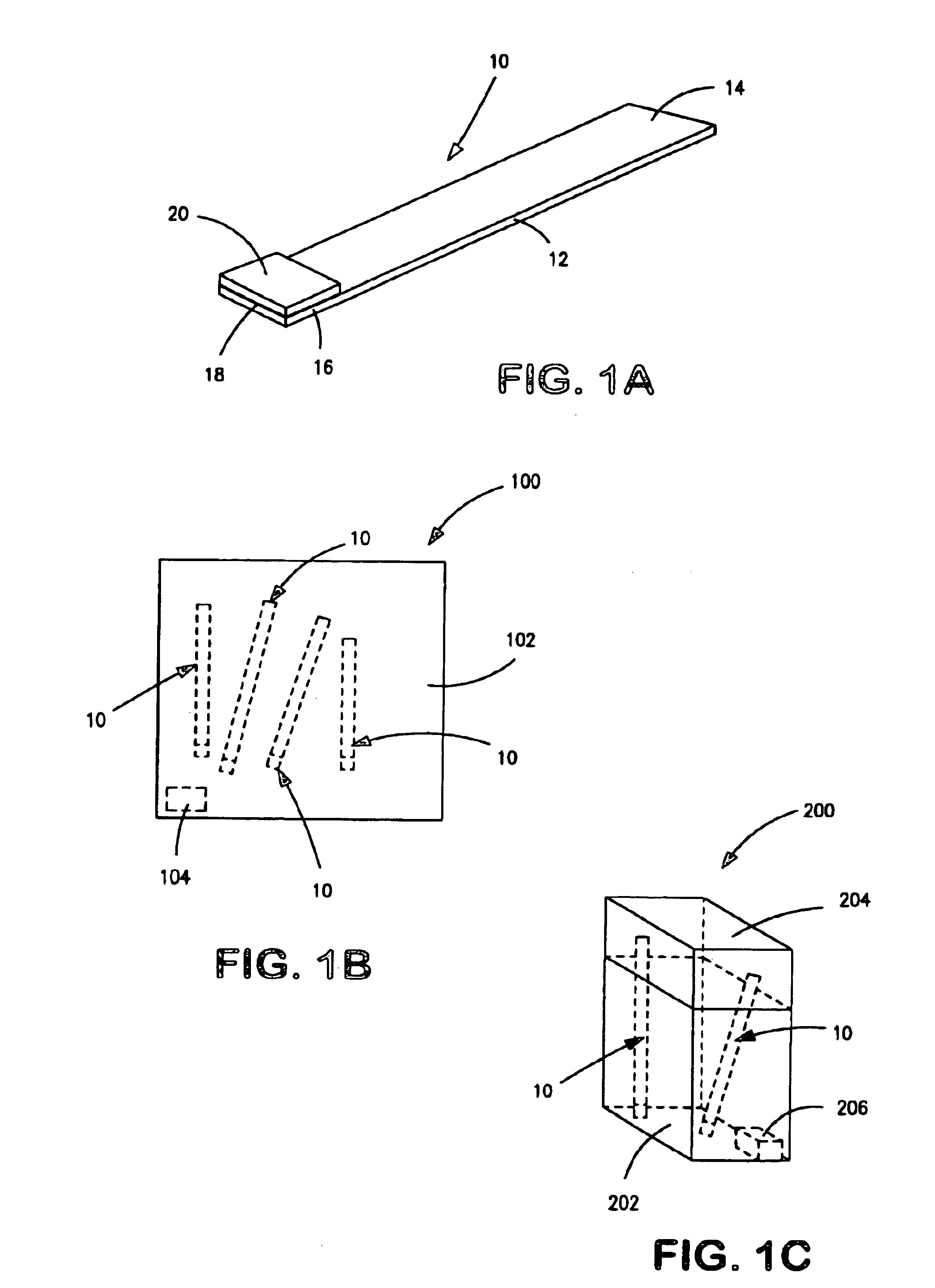Controls and standards for assays and method for manufacture thereof
a technology of control and standards, applied in chemical methods analysis, instruments, enzymology, etc., can solve the problems of difficult correlation, particular acute problems, and variation in the actual concentration of materials, and achieve the effect of simple preparation and simple us
- Summary
- Abstract
- Description
- Claims
- Application Information
AI Technical Summary
Benefits of technology
Problems solved by technology
Method used
Image
Examples
example 1
[0275]Preparation of control strips for the following examples was as follows.
[0276]Porous carrier material was cut into 4 mm wide strips. The carrier materials which were used comprised nylon pads (from Schleicher & Schuell) or glass fiber pads such as Whatman Rapid Q27, Schleicher & Schuell (S&S) #33, Millipore T9BM0515, or Millipore GFCP203000.
[0277]For treated porous carrier materials, the carrier materials were soaked briefly in pretreatment buffer 01 consisting of 40 mM dibasic sodium phosphate, 9.5 mM monobasic sodium phosphate, 0.1% (w / v) bovine serum albumin, 0.1% polyoxyethylenesorbitan monolaurate, and 3 mM sodium azide or in phosphate buffered sucrose consisting of 4.4 mM sucrose (about 15% (w / v)) in 8.2 mM dibasic sodium phosphate, 2.7 mM potassium chloride, 1.5 mM monobasic sodium phosphate, and 137 mM sodium chloride. Afterwards, the carrier materials were dried overnight at room temperature. In general, the carrier materials treated with pretreatment buffer were used...
example 2
[0280]This example illustrates the method for making and using bacterial controls and standards for ELISAs using nylon pads as the porous carrier material.
[0281]Xanthamonas campestris pv. pelargonii (Xcp), a geranium pathogen was suspended in phosphate buffered saline (PBS: 8.2 mM dibasic sodium phosphate, 2.7 mM potassium chloride, 1.5 mM monobasic potassium phosphate, and 137 mM sodium chloride). Then, 5, 6, and 7 μL aliquots of the suspension were each applied to separate untreated nylon pads adhered to plastic card stock as described in Example 1. After allowing the nylon pads to dry overnight, each nylon pad on plastic card stock was cut into triplicate strips.
[0282]Each of the triplicate strips was placed in a well of an ELISA plate containing 100 μL of extraction buffer suitable for the plant tissue to be assayed. As a control, 5, 6, and 7 μL aliquots of the Xcp suspension were pipetted in triplicate wells containing the extraction buffer as well. After about two hours at roo...
example 3
[0284]This example illustrates the method for making and using viral controls and standards for ELISAs using nylon pads. The viruses used in this example were obtained from lyophilized infected tissue.
[0285]Lyophilized impatiens necrotic spot virus (INSV) infected ornamental tissue and tomato spotted wilt virus (TSWV) infected tissue were each reconstituted in phosphate buffered saline (PBS) and in distilled water. Then, 10 μL aliquots of each suspension was applied to separate untreated nylon pads adhered to plastic card stock as described in Example 1. After allowing the nylon pads to dry overnight at room temperature, each was cut into triplicate strips.
[0286]Lyophilized arabis mosaic virus (ArMV) infected vinca tissue and potato virus M (PVM) were reconstituted in PBS and in distilled water. Then, 10 μL aliquots were applied to separate nylon pads pretreated with pretreatment buffer 01 and adhered to plastic card stock as described in Example 1. After allowing the nylon pads to ...
PUM
| Property | Measurement | Unit |
|---|---|---|
| temperature | aaaaa | aaaaa |
| temperatures | aaaaa | aaaaa |
| temperatures | aaaaa | aaaaa |
Abstract
Description
Claims
Application Information
 Login to View More
Login to View More - R&D
- Intellectual Property
- Life Sciences
- Materials
- Tech Scout
- Unparalleled Data Quality
- Higher Quality Content
- 60% Fewer Hallucinations
Browse by: Latest US Patents, China's latest patents, Technical Efficacy Thesaurus, Application Domain, Technology Topic, Popular Technical Reports.
© 2025 PatSnap. All rights reserved.Legal|Privacy policy|Modern Slavery Act Transparency Statement|Sitemap|About US| Contact US: help@patsnap.com



